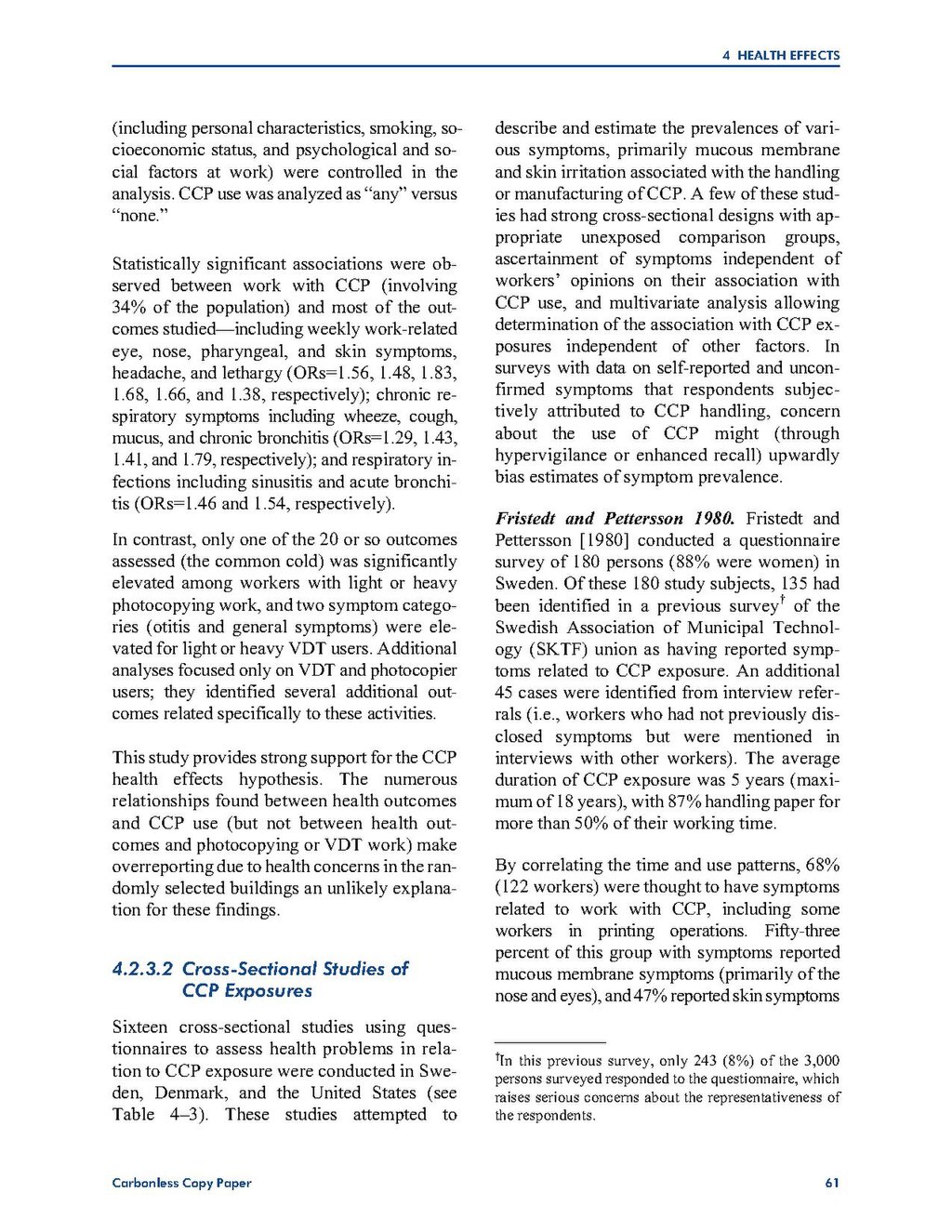(including personal characteristics, smoking, socioeconomic status, and psychological and social factors at work) were controlled in the analysis. CCP use was analyzed as "any" versus "none."
Statistically significant associations were observed between work with CCP (involving 34% of the population) and most of the outcomes studied—including weekly work-related eye, nose, pharyngeal, and skin symptoms,headache, and lethargy (ORs=1.56, 1.48, 1.83, 1.68, 1.66, and 1.38, respectively); chronic respiratory symptoms including wheeze, cough, mucus, and chronic bronchitis (ORs=1.29, 1.43, 1.41, and 1.79, respectively); and respiratory infections including sinusitis and acute bronchitis (ORs=1.46 and 1.54, respectively). In contrast, only one of the 20 or so outcomes assessed (the common cold) was significantly elevated among workers with light or heavy photocopying work, and two symptom categories (otitis and general symptoms) were elevated for light or heavy VDT users. Additional analyses focused only on VDT and photocopier users; they identified several additional outcomes related specifically to these activities. This study provides strong support for the CCP health effects hypothesis. The numerous relationships found between health outcomes and CCP use (but not between health outcomes and photocopying or VDT work) make overreporting due to health concerns in the randomly selected buildings an unlikely explanation for these findings.
4.2.3.2 Cross-Sectional Studies of CCP Exposures
Sixteen cross-sectional studies using questionnaires to assess health problems in relation to CCP exposure were conducted in Sweden, Denmark, and the United States (see Table 4–3). These studies attempted to describe and estimate the prevalences of various symptoms, primarily mucous membrane and skin irritation associated with the handling or manufacturing of CCP. A few of these studies had strong cross-sectional designs with appropriate unexposed comparison groups, ascertainment of symptoms independent of workers' opinions on their association with CCP use, and multivariate analysis allowing determination of the association with CCP exposures independent of other factors. In surveys with data on self-reported and unconfirmed symptoms that respondents subjectively attributed to CCP handling, concern about the use of CCP might (through hypervigilance or enhanced recall) upwardly bias estimates of symptom prevalence.
Fristedt and Pettersson 1980. Fristedt and Pettersson [1980] conducted a questionnaire survey of 180 persons (88% were women) in Sweden. Of these 180 study subjects, 135 had been identified in a previous survey[1] of the Swedish Association of Municipal Technology (SKTF) union as having reported symptoms related to CCP exposure. An additional 45 cases were identified from interview referrals (i.e., workers who had not previously disclosed symptoms but were mentioned in interviews with other workers). The average duration of CCP exposure was 5 years (maximum of 18 years), with 87% handling paper for more than 50% of their working time.
By correlating the time and use patterns, 68% (122 workers) were thought to have symptoms related to work with CCP, including some workers in printing operations. Fifty-three percent of this group with symptoms reported mucous membrane symptoms (primarily of the nose and eyes), and 47% reported skin symptoms
- ↑ In this previous survey, only 243 (8%) of the 3,000 persons surveyed responded to the questionnaire, which raises serious concerns about the representativeness of the respondents.

